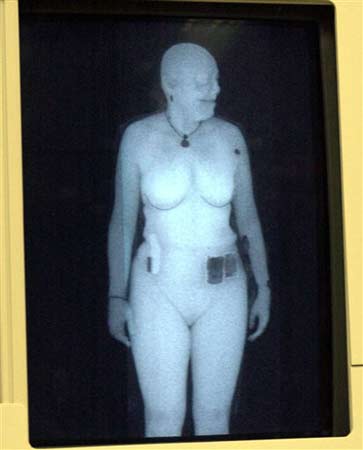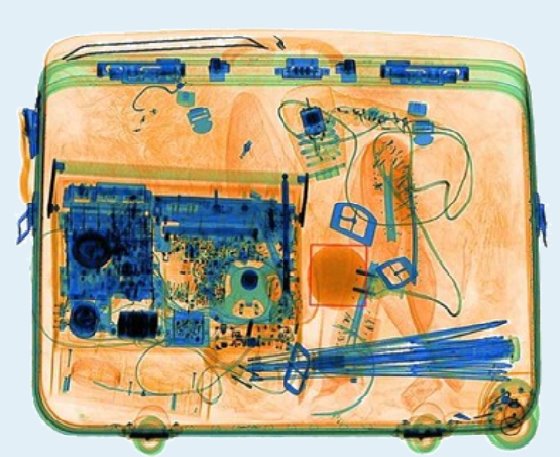The STP or CTP is used to ensure that the performance requirements for X-ray machines set out are met and maintained.Some times it is called Combined Test Piece (CTP) .The STP contains samples of organic and inorganic material, materials for resolution and penetration tests.
SINGLE WIRE RESOLUTION (TEST No.1)

SINGLE WIRE RESOLUTION (TEST No.1)
A set of un-insulated tinned copper
wires of size 26, 30, 35, 38, 40 and 42 SWG or corresponding AWG wires are placed on Perspex sheet. The
wires are laid out in 'S" shaped curves.
The wires are placed behind varying thickness
of aluminium. A quarter of the length of each wire is uncovered whilst the
remaining 3 quarters are covered by 3 wedges of aluminium, corresponding to
4.8mm (3/16"), 7.9mm (5/16") and 11.1mm (7/16") thickness. The minimum requirement
is to display 40 SWG wire not covered by step wedge for most of the machines. Metallic marker should be provided using
high-density material, so that SWG numbers in the Display are clearly visible.
USEFUL
PENETRATION (TEST No.2)
Defines what level of details can be seen behind a thickness
of known material. The requirement of this test is that the 26 SWG wire is seen
under step wedge of 5/16 thickness of Aluminium.
MULTI ENERGY X-RAY (TEST No. 3)
With multi-energy X-Ray, it should be possible to distinguish
between materials of different average atomic number. The use of sugar and salt
samples encapsulated on the test piece of CTP will check the material
discrimination facility. A different color of sugar and salt on display indicate that the sugar/salt samples are
shown in different color.
SIMPLE PENETRATION
(TEST No. 4)
This test defines what thickness of steel the machine should
be able to penetrate. The steel step wedge on the CTP has steps of 2 mm from 20
mm to 40 mm with a lead strip, 1.5mm in thickness to check that the machine is
above or below the requirement. The requirement will be different for different
KV machines.
SPATIAL RESOLUTION
(TEST No. 5)
This test defines the ability of the
system to distinguish and display objects which are close together. The CTP has
copper plate with three sets of gratings (1.0mm, 1.5mm and
2.0mm). Each set consists of a horizontal group and a vertical
group. The requirement is that a vertical and horizontal grating can be seen.
THIN METAL IMAGING
(TEST No. 6)
This is to test the machine‘s ability
to image thin metal. This involves a three thin squares of steel of 0.15mm,
0.10mm and 0.05mm thickness placed in row and the requirement is to image steel
strip of 0.1 mm thickness.
THIN ORGANIC IMAGING
(TEST No. 7)
This is to test the machine‘s capability for thin organic
imaging. The test object incorporates plastic of various thicknesses and the
requirement is to image plastic of 1 mm thickness.
IQI SENSITIVITY (TEST
No. 8)
This is to determine the image quality indicator (IQI) sensitivity of the X-ray system. The requirement is to demonstrate 2% IQI sensitivity.
The CTP must be placed with its longest
dimension parallel to the direction of belt.
The CTP should be
placed in the best position for optimum performance.The optimum position of the STP on the belt depends on the x-ray source and detector arrangements, with the aim being to obtain the best result possible.





29 comments:
Y aluminium is used in second test of CTP,even we know to find what level of details can be seen behind thickness of known material,..but y only aluminium is used when there are lot if known materials?
1. Y only 8 & 8 vertical and horizontal gratings used in fifth test and y it is with copper ? Even there are lot of other materials which show blue only on screen but y copper only.
2.To check penetration level of xrays we use simple penetration test,but y it only steel is used in CTP box? And 30mm is requirement but if u got a material with heavy thickness then which button is used to find what is present behind dat thick material
3.In single wire resolution uninsulated copper wire is used but if terrorist may use insulated wire,then what is the purpose of uninsulated wire in ctp? We can also use insulated wire in CTP but y we choosed uninsulated one in ctp
What is deference between useful & Simple penetration test. Both test shows penetration power. pls clear it with example
The main aim to this test is to see electrical circuit behind cabinets used for electronic goods which is usually used by people. No company makes heavy cabinets for equipments and materials used to make cabinets are supposed to be lighter than aluminium. So aluminium plates are used for this test.
1. Copper can not get rusting and usually not effected by variation in room temperature. Here aim is to see gratings and so copper plates are used.
Simple penetration only gives informations regarding normal penetration capabilities of the X-BIS. Most commonly used elements to hide something is steel and so steel is chosen. Rest materials penetration is done in compare to steel as per density. High penetration or VARI key can be used to enhance penetration level of machine in addition.
3. Purpose is to see actual width of wire physically and to see the same in X-BIS image and compre. Even if we use insulated wire result will be almost same.
What is uses of fourth test
Very nice blog! Keep going. I want to tell you that we are a manufacturer of explosives traces detectors and instruments for soil contamination surveys. Our mission is homeland safety and security. Security Screening, Explosive Trace Detector Parts
I want to ask u if 40SWG wire carrying underneath 5/16 aluminum wedge how could we found it
Plz expand in hindi
Y below 40SWG wire will not be used in construction of an IED
Why 8 horizontal and 8 vertical why can't we take another digit?
Y perpex sheet is used in single wire resolution 1st test
Y 1st test is in s shape?
Can use but the swg can be easily identified. Higher the SWG wire will be thin
Use SEN key
To see clear image of wire without reflection
If we place wires in bag it will not in straight shape hence s shape is used
Nice discussion
Good information
Why used perspex sheet in 1st test?? and why used perspex sheet un insulated copper wire??
I’m shocked read your article on your blogger amazing information get to usefully knowable tips. Like At Medimages, we design and develop advanced medical imaging software solutions. PACS Software, DICOM Software.
Y we use uninsulated wire for 1st and 2nd test?
Please upload video demonstration of CTP Test of X-Bis so we can easily learn from this...
In second test why 30 swg and why second step wedge?
I appreciate you sharing this information; this is a nice blog. But, I also would like to share about the goods and services we offer. Gujar Industries is a well-known name in the Indian market. Famous for best x ray security machines. Read More..
Know All Specification and Features of X-Ray Baggage Scanner
How X Ray Baggage Inspection System Makes the Security Work Simple and Easy
https://www.gujarindustries.com/blog/lesser-known-features-of-a-baggage-scanner-machine/
I have a dout on 2nd test which is useful penetratiion. In this test it has 3 step wage 3/16,5/16.7/16. And the requirement is 26swg uninsulated copper wire to be seen under 2nd step wage 5/16. My question is why only 2nd step wage why not 1st or 3rd. Please clear it
Needed an urgent x-ray, and happily found a fantastic facility close by. Modern equipment, quick service, and well-trained personnel.
xray near me
Post a Comment